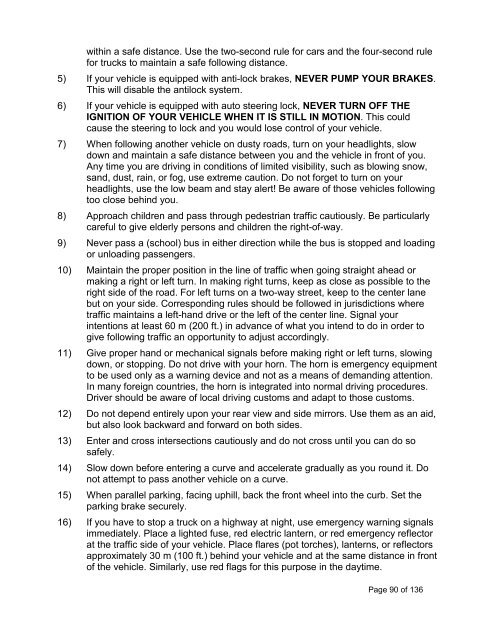IAGC LAND GEOPHYSICAL SAFETY MANUAL Edition 9 ... - CGISS
IAGC LAND GEOPHYSICAL SAFETY MANUAL Edition 9 ... - CGISS
IAGC LAND GEOPHYSICAL SAFETY MANUAL Edition 9 ... - CGISS
- No tags were found...
Create successful ePaper yourself
Turn your PDF publications into a flip-book with our unique Google optimized e-Paper software.
within a safe distance. Use the two-second rule for cars and the four-second rulefor trucks to maintain a safe following distance.5) If your vehicle is equipped with anti-lock brakes, NEVER PUMP YOUR BRAKES.This will disable the antilock system.6) If your vehicle is equipped with auto steering lock, NEVER TURN OFF THEIGNITION OF YOUR VEHICLE WHEN IT IS STILL IN MOTION. This couldcause the steering to lock and you would lose control of your vehicle.7) When following another vehicle on dusty roads, turn on your headlights, slowdown and maintain a safe distance between you and the vehicle in front of you.Any time you are driving in conditions of limited visibility, such as blowing snow,sand, dust, rain, or fog, use extreme caution. Do not forget to turn on yourheadlights, use the low beam and stay alert! Be aware of those vehicles followingtoo close behind you.8) Approach children and pass through pedestrian traffic cautiously. Be particularlycareful to give elderly persons and children the right-of-way.9) Never pass a (school) bus in either direction while the bus is stopped and loadingor unloading passengers.10) Maintain the proper position in the line of traffic when going straight ahead ormaking a right or left turn. In making right turns, keep as close as possible to theright side of the road. For left turns on a two-way street, keep to the center lanebut on your side. Corresponding rules should be followed in jurisdictions wheretraffic maintains a left-hand drive or the left of the center line. Signal yourintentions at least 60 m (200 ft.) in advance of what you intend to do in order togive following traffic an opportunity to adjust accordingly.11) Give proper hand or mechanical signals before making right or left turns, slowingdown, or stopping. Do not drive with your horn. The horn is emergency equipmentto be used only as a warning device and not as a means of demanding attention.In many foreign countries, the horn is integrated into normal driving procedures.Driver should be aware of local driving customs and adapt to those customs.12) Do not depend entirely upon your rear view and side mirrors. Use them as an aid,but also look backward and forward on both sides.13) Enter and cross intersections cautiously and do not cross until you can do sosafely.14) Slow down before entering a curve and accelerate gradually as you round it. Donot attempt to pass another vehicle on a curve.15) When parallel parking, facing uphill, back the front wheel into the curb. Set theparking brake securely.16) If you have to stop a truck on a highway at night, use emergency warning signalsimmediately. Place a lighted fuse, red electric lantern, or red emergency reflectorat the traffic side of your vehicle. Place flares (pot torches), lanterns, or reflectorsapproximately 30 m (100 ft.) behind your vehicle and at the same distance in frontof the vehicle. Similarly, use red flags for this purpose in the daytime.Page 90 of 136
















